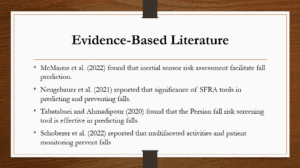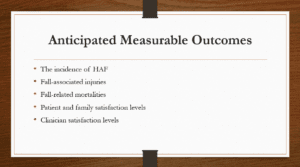Presentation for Faculty Review and Feedback

We will begin by describing the evidence-based intervention and then present evidence-based literature to support the intervention. Next, we will identify the objectives of the change proposal and the resources needed for the success of the intervention. After that, we will explain the anticipated outcomes. Finally, we will delve into the strategy for evaluating the intervention.
The proposed intervention is a standardized fall risk assessment (SFRA). This intervention enables clinicians to identify factors predisposing patients to falls (Neugebauer et al., 2021). By so doing, it plays a key role in mitigating hospital-associated falls. SFRA improves care delivery through various strategies. To begin with, it enables clinicians to make informed clinical decisions when caring for patients (Neugebauer et al., 2021). By so doing, clinicians formulate individualized plans that fulfil patients’ needs. Also, SFRA optimizes communication between members of the interdisciplinary team and between different healthcare facilities (Neugebauer et al., 2021). This improves the quality of care for patients. Furthermore, SFRA enables clinicians to achieve comprehensive care by linking and adopting various strategies that prevent falls.
Various SFRA tools are used in contemporary practice. However, it is worth noting that these tools lack perfect predictability of falls (Networkofcare.org, n.d.). As such, clinicians should initiate preventive strategies in all patients (low and high-risk). The Morse Fall Scale is an example of an SFRA that will be leveraged. This SFRA tool evaluates various predictors of falls. They include fall history, secondary diagnoses, medication use (heparin), mental status, gait, and the presence of ambulatory aids (Networkofcare.org, n.d.). Standard interventions for mitigating falls should be initiated in low-risk patients (score of 25 to 50) (Networkofcare.org, n.d.). On the other hand, high-risk strategies for mitigating falls should be implemented in high-risk patients (score of 51 and above) (Networkofcare.org, n.d.).
I sought peer-reviewed articles from online databases found at GCU’s library. Online databases such as CINAHL and Cochrane Library enabled me to customize my searches and access current peer-reviewed articles. I used Boolean operators such as “AND” to combine my search terms and obtain relevant search results. After that, I leveraged CRAAP criteria to evaluate the reliability and credibility of my peer-reviewed articles. As such, I selected eight peer-reviewed articles to guide my literature evaluation.
The study by Cho and Jang (2020) revealed that nurses have limited knowledge and skills in preventing hospital-associated falls (HAF). As such, they should be trained and educated on the strategies for preventing HAF. On the other hand, Dykes et al. (2020) reported that the implementation of a standardized fall prevention tool decreased the incidence of HAF by 15 per cent. The study by Ganz and Latham (2020) revealed that multifactorial assessments enable clinicians to formulate individualized fall-prevention care plans. Additionally, continuous monitoring and review of medication and physical exercise facilitate fall prevention. Further, Haescher et al. (2020) reported that technology, such as wearable devices, facilitates risk assessment. This enables healthcare practitioners to formulate individualized fall prevention plans.
The study by McManus et al. (2022) identified the relevance of inertial sensor risk assessment in predicting the risk of falls. This tool can be used in the elderly population and enable healthcare practitioners to formulate patient-centred care plans. Similar findings were reported by Neugebauer et al. (2021) and Tabatabaei and Ahmadipour (2020). According to Neugebauer et al. (2021), SFRA tools formed the basis for the timely identification of fall risk factors and guided the formulation of patient-centred care plans. Tabatabaei and Ahmadipour (2020) reported that the Persian fall risk screening tool effectively predicts moderate to high-risk falls. Lastly, the study by Schoberer et al. (2022) revealed that multifaceted approaches, patient monitoring, and physical exercise play a key role in mitigating falls.
The first objective of the evidence-based intervention and change proposal is to evaluate the impact of an SFRA tool on the incidence of HAF. The second objective is to implement SFRA among the elderly population visiting the healthcare facility’s emergency department. The third objective is to evaluate the impact of an SFRA tool on injuries attributed to HAF. Finally, the evidence-based intervention and change proposal aims to determine the impact of an SFRA on patients’ and clinicians’ satisfaction levels.
Various resources are required to promote the success of the EBP proposal. Firstly, adequate human resources should be allocated to the project. Nurses will play a significant role in screening patients based on the SFRA tool. Also, they will be involved in implementing individualized management plans for each patient and formulating nursing care plans. Physicians will be key in screening patients and formulating individualized prevention care plans. Heads of departments will play a key role in monitoring and evaluating the actions of nurses and physicians to promote the success of the EBP proposal. Finally, administration members will play a key role in overseeing the implementation of the EBP proposal by allocating resources as needed.
Secondly, adequate allocation of monetary resources will promote the success of the EBP proposal. To begin with, monetary allocation will facilitate the training of all stakeholders. This will entail the formulating and printing of handouts to facilitate the training. Also, monetary allocation will promote the formulation and dissemination of the SFRA tool. As earlier stated, the Morse Fall Scale will be leveraged. Additional aspects will be added to this scale to meet the healthcare facility’s needs. Lastly, monetary allocations will promote the appropriate use of technology. In this context, stakeholders will be trained on using barcodes and the electronic health record system to promote accurate patient identification.
Various measurable outcomes are anticipated. Firstly, the incidence of HAF is a key measurable outcome that indicates the number of new fall-related cases recorded at the hospital after implementing the EBP proposal. This will be presented as percentages. The second outcome is the number of fall-associated injuries, which indicates falls recorded after implementing the EBP proposal. This outcome will also be reported as a percentage. The third outcome is fall-related mortalities, which will indicate fall-associated deaths recorded at the healthcare facility after implementing the EBP proposal. The other measurable outcomes are patient and family and clinicians’ satisfaction levels. These outcomes will be measured using a rating scale. They will demonstrate the impact of the EBP on patients and healthcare practitioners.
The incidence of HAF, three months after implementing the EBP proposal will be assessed to determine the impact of the intervention. Electronic medical records will be accessed to provide pertinent information regarding patients’ hospital stays. The incidence of HAF will be compared with the cases reported before the implementation of the EBP proposal. A decrease in the cases of hospital-associated falls after the intervention’s implementation will demonstrate the intervention’s success.
References
Burnes, B. (2020). The Origins of Lewin’s Three-Step Model of Change. Journal of Applied Behavioral Science, 56(1), 32–59. https://doi.org/10.1177/0021886319892685
Cho, M. young, & Jang, S. J. (2020). Nurses’ knowledge, attitude, and fall prevention practices at South Korean hospitals: a cross-sectional survey. BMC Nursing, 19(1), 1–8. https://doi.org/10.1186/s12912-020-00507-w
Dykes, P. C., Burns, Z., Adelman, J., Benneyan, J., Bogaisky, M., Carter, E., Ergai, A., Lindros, M. E., Lipsitz, S. R., Scanlan, M., Shaykevich, S., & Bates, D. W. (2020). Evaluation of a Patient-Centered Fall-Prevention Tool Kit to Reduce Falls and Injuries: A Nonrandomized Controlled Trial. JAMA Network Open, 3(11), e2025889. https://doi.org/10.1001/jamanetworkopen.2020.25889
Ganz, A. D., & Latham, K. L. (2020). Prevention of falls in community-dwelling older adults. The New England Journal of Medicine, 86(12). https://doi.org/10.1056/NEJMcp1903252
Haescher, M., Chodan, W., Höpfner, F., Bieber, G., Aehnelt, M., Srinivasan, K., & Murphy, M. A. (2020). Automated fall risk assessment of the elderly using wearable devices. Journal of Rehabilitation and Assistive Technologies Engineering, 7, 205566832094620. https://doi.org/10.1177/2055668320946209
McManus, K., Greene, B. R., Ader, L. G. M., & Caulfield, B. (2022). Development of Data-Driven Metrics for Balance Impairment and Fall Risk Assessment in Older Adults. IEEE Transactions on Biomedical Engineering, 69(7), 2324–2332. https://doi.org/10.1109/TBME.2022.3142617
Networkofcare.org. (n.d.). Morse Fall Scale. https://networkofcare.org/library/Morse%20Fall%20Scale.pdf
Neugebauer, J., Tóthová, V., & Doležalová, J. (2021). Use of standardized and non-standardized tools for measuring the risk of falls and independence in clinical practice. International Journal of Environmental Research and Public Health, 18(6), 1–11. https://doi.org/10.3390/ijerph18063226
Schoberer, D., Breimaier, H. E., Zuschnegg, J., Findling, T., Schaffer, S., & Archan, T. (2022). Fall prevention in hospitals and nursing homes: Clinical practice guideline. Worldviews on Evidence-Based Nursing, 19(2), 86–93. https://doi.org/10.1111/wvn.12571
Tabatabaei, H. R., & Ahmadipour, H. (2020). Fall‑Risk Assessment in the Elderly Using the Persian Version of Fall‑Risk Screening Tool: A Population‑Based Study. International Journal of Preventive Medicine, 11. https://doi.org/ 10.4103/ijpvm.IJPVM_198_19
ORDER A PLAGIARISM-FREE PAPER HERE
We’ll write everything from scratch
Question

Presentation for Faculty Review and Feedback
Create a 10-15 slide PowerPoint presentation of your evidence-based intervention and change proposal to be disseminated to an interprofessional audience of leaders and stakeholders. Include the intervention, evidence-based literature, objectives, resources needed, anticipated measurable outcomes, and how the intervention would be evaluated. Submit the presentation in the digital classroom for feedback from the instructor.














